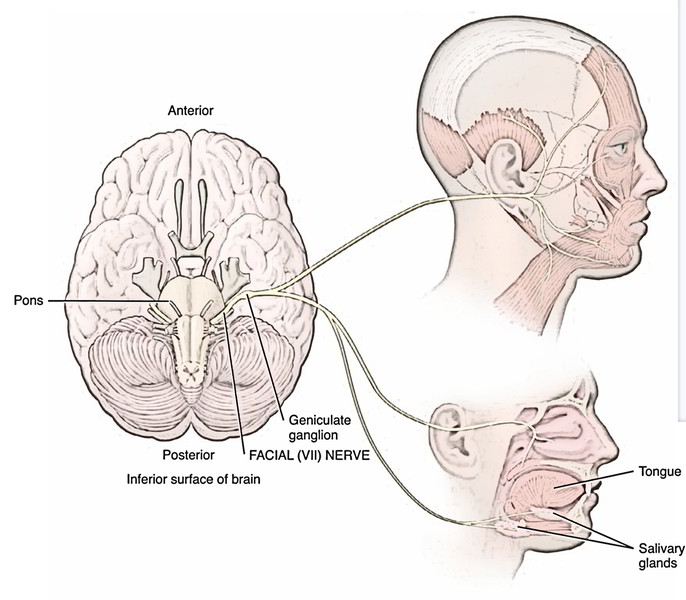The facial nerve comes out of cranial cavity, between the styloid and mastoid processes of the temporal bone via the stylomastoid foramen at the base of the skull.
After coming from the foramen, it enters the posteromedial aspect of the parotid gland on the superficial plane and it bends forwards around the lateral aspect of the root of the styloid process. It runs superficial to the retromandibular vein for about 1 cm in the gland and after that splits into 2 trunks: (a) the temporofacial and (b) the cervicofacial. The cervicofacial trunk enters downwards and forwards and splits into buccal, marginal mandibular and cervical terminal branches. The temporofacial trunk subdivides into temporal and zygomatic terminal branches and runs upwards.
Branches
Below the base of the skull, the facial nerves generate the following branches:
Posterior auricular nerve: It appears just below the stylomastoid foramen and ascends between the mastoid process and the rear of the external acoustic meatus. It supplies occipital belly of occipitofrontalis, auricularis posterior and auricularis superior (intrinsic muscles of the ear).
Branch to the posterior belly of digastric: It appears near the origin of the prior nerve and following an extremely brief course supplies the muscle. It also supplies a branch to the stylohyoid muscle.
Terminal branches: These are 5 in number, viz.:
- Temporal branch- run upwards and cross the zygomatic arch.
- Zygomatic branches- run below and parallel to the zygomatic arch.
- Buccal branches- are two in number. The upper buccal nerve runs above the parotid duct and the lower buccal nerve runs below the duct.
- Fringy mandibular (also referred to as mandibular) branch- runs forwards below the angle of the mandible, deep to the platysma. It then crosses the body of the mandible to supply the muscles of the lower lip and chin.
- Cervical branch- runs downwards and forwards to get to the front of the neck, to supply the platysma.
The terminal branches convey with the sensorybranches of the trigeminal nerve.
Clinical Significance
Mumps (viral parotitis): It’s a contagious disease caused by a particular virus referred to as mumps virus (myxovirus). It presents as an acute inflammation and swelling of the gland. There’s diffuse enlargement of the parotid gland (parotid swelling) related to pain and temperature. The pain is accentuated by jaw movement as the part of the gland between the external auditory meatus and temporomandibular joint is compressed. The opening of parotid duct becomes swollen and congested. It largely affects children below 15 years old. The viral parotitis characteristically doesn’t suppurate. The viremia related to mumps can cause complications in the grownups like epididymo-orchitis, pancreatitis, or oophoritis, etc.
Parotid abscess: The parotid abscess may take place by spread of infection from the oral cavity. A parotid abscess may spread into parapharyngeal spaces or break open spontaneously on the cheek or in the external auditory meatus.
Drainage of the parotid abscess: A preauricular incision is created in the skin in the root of the auricle and skin flap lifted to expose the parotid fascia. The abscess is drained by a stark horizontal incision in the parotid capsule, parallel to the branches of the facial nerve (Hilton’s procedure).
Bell’s palsy: It’s lower motor neuron type paralysis of facial muscles because of compaction of facial nerve in the facial canal near stylomastoid foramen. The precise etiology isn’t understood but it’s likely because of viral infection.


 (45 votes, average: 4.75 out of 5)
(45 votes, average: 4.75 out of 5)